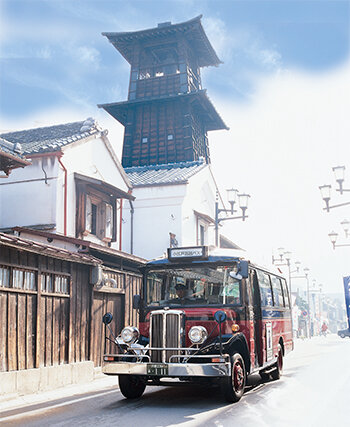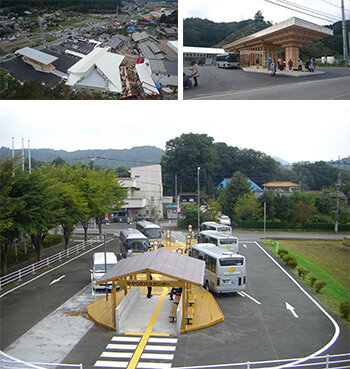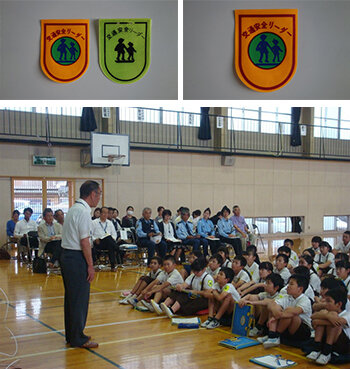No.41 In 2019
Title
Contributing to the Community through Visualized Bus Services-Ceaseless Efforts to Improve Convenience and Create Tourism Demand-
Recipient
Eagle Bus Co.

Reason for award
Eagle Bus Co. has implemented a unique bus business improvement system, and practices sustainable bus business through visualization. Our efforts to prevent our bus business from falling into the red are based on meticulous data analysis. By aggregating data on passenger numbers at each bus stop, congestion, delays, and other factors, and using GPS, boarding sensors, and other ICT tools, we are able to identify bus stops and times when few passengers get on and off of buses. This is an exceptionally cutting-edge effort to make it possible to visualize a part of the bus business that had previously been supported only by intuition and experience. We have also introduced thorough marketing research methods into our bus business, combining them with the results of user need surveys to optimize routes and operating schedules. These ambitious efforts not only reduce operating costs, but also improve convenience and increase bus ridership. There are many lessons to be learned from Eagle Bus's business model when it comes to overcoming the challenges faced by many bus operators in Japan, who operate at a loss and maintain unprofitable routes. We have also established a centralized hub in an underpopulated area, and successfully created demand for local tourism. This has been made possible by the introduction of a "hub-and-spoke" local bus transfer system, which not only serves as a centralized bus center for multiple routes, but also functions as a small-town hub by providing lifestyle service facilities, such as a pharmacy, a medical clinic, and a post office.

Taking advantage of the characteristics of the area, the hub-and-spoke system has also successfully attracted tourists by providing a tourist center, shopping facilities for souvenirs and other items, and hands-on tourism facilities. The introduction of this hub-and-spoke system has not only improved the quality of mobility and lifestyle services for local residents, but has also contributed to the creation of new demand for local tourism -- a significant benefit to the community provided by Eagle Bus. Eagle Bus President and CEO Masaru Yajima, a certified Regional Public Transportation Meister, has placed contributions to the local community at the center of his bus business, including the operation of a sightseeing bus that travels around Kawagoe City.
Today, he is involved in a project to provide the know-how developed through this bus business improvement system to Vientiane Bus Corporation in Laos, to help them optimize their local bus operation; the Eagle Bus business model is expected to help contribute to the development of regional public transportation and tourism business in Laos, as well, and these efforts to put these ideas into practice both domestically and internationally have earned high praise.
Title
Traffic Safety Education Activities, with All Sixth-Grade Students in the Prefecture Serving as Traffic Safety Leaders
Recipient
Shizuoka Prefecture

Reason for award
All elementary schools in Shizuoka Prefecture have a unique traffic safety education program called the Traffic Safety Leader System, as a part of efforts to prevent children from being involved in traffic accidents. The Traffic Safety Leader System was established as a way to create a better traffic safety environment, and to eliminate tragic traffic accidents involving children by designating older elementary school students as traffic safety leaders and having them wear leader badges, so that the leaders themselves can demonstrate traffic rules and teach younger students how to behave in traffic. In 1976, it was decided to designate all sixth-grade students in the prefecture as traffic safety leaders.
In addition, meetings with traffic safety leaders (to discuss traffic safety with parents) are held as events related to this system. The traffic safety leaders present handmade maps that they have prepared of dangerous spots in each area, and have discussions on how to prevent accidents, with people involved in traffic safety in the community like parent and guardian representatives, the Traffic Safety Section, the Board of Education, the Traffic Section of the police department, neighborhood associations, and traffic safety associations, to help promote traffic safety activities. This event has been held annually at every public elementary school in the prefecture since 1987. During the 2008-2009 school year, about 30,000 traffic safety leaders participated, and the total number of participants, including other children, parents, community members, and teachers, was 58,000. This is a very practical, large-scale initiative not seen in any other prefecture.

Elsewhere in the world, there is a similar initiative found in the United Kingdom, where representative children become Junior Road Safety Officers. In contrast, this initiative in Shizuoka Prefecture is unique, because every sixth grader serves as a traffic safety leader. All sixth-graders are taught to be aware of their role as traffic safety leaders, and by being involved in the creation of hazard maps and exchanging ideas with community stakeholders, they are expected to learn how to be proactive and interested in their communities, instead of leaving the creation of safe neighborhoods to organizations like the police or the government. The fact that native residents of the prefecture, ranging in age from sixth grade to 55 years old, have all already received this kind of education is believed to have contributed to the enhancement of social capital, such as the improvement of traffic safety through local autonomy. However, such efforts have been taken for granted in Shizuoka Prefecture for so long that their importance is no longer recognized.
Safety on school routes has been in the spotlight in recent years, and this initiative has improved the region's traffic safety environment by promoting communication between people involved in traffic safety, built around sixth-grade students, and it is expected to spread to other prefectures in Japan.
